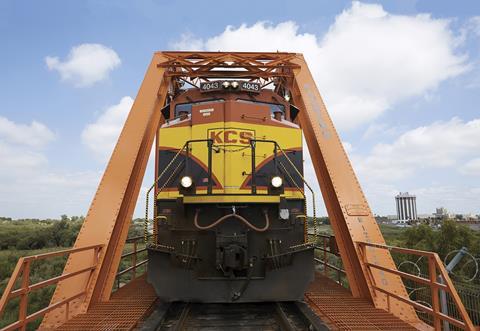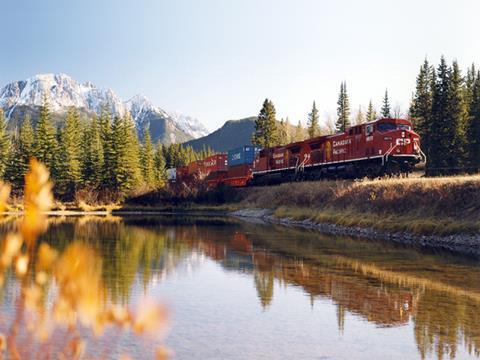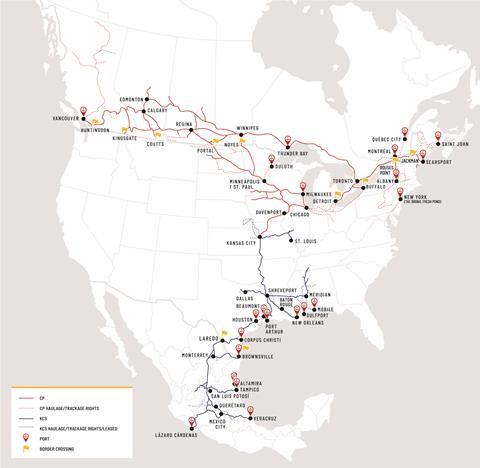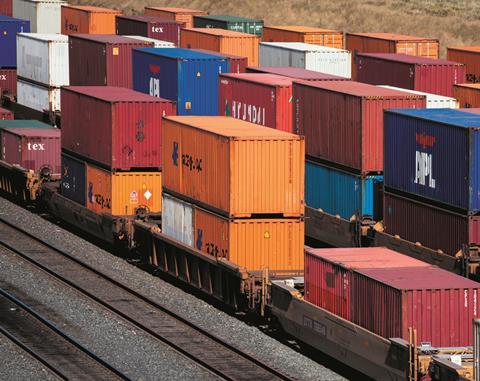
NORTH AMERICA: Canadian Pacific and Kansas City Southern have formally filed a merger application with the US Surface Transportation Board, setting out their aim of establishing a single network linking the USA, Mexico and Canada before the end of 2022.
Following a six-month contest with rival operator Canadian National, CP agreed in mid-September to acquire KCS through a stock and cash transaction representing an enterprise value of approximately US$31bn, including the assumption of US$3·8bn of KCS debt. The shareholders of both companies are expected to vote on the transaction later this year, and the merger must also be approved by the Mexican regulatory authorities.

CP’s control of KCS operations in the USA is subject to STB approval. In April the board determined it would review a proposed CP-KCS combination under the merger rules in existence prior to 2001, using a waiver excepting KCS from tighter M&A regulations brought in at that time. This decision was reaffirmed by the board in August, and on September 30 STB confirmed that it had also approved the use of a voting trust to facilitate the CP-KCS combination.
That would allow CP to pay the KCS shareholders and acquire the smaller railway, putting it into an independently-controlled trust pending completion of the regulatory review. The regulatory process is now expected to be completed in the second half of 2022, after which the two railways would be fully integrated over the following three years.
According to the applicants, more than 960 stakeholders have written to the STB supporting the proposed combination. This includes ‘440 shippers, 186 smaller railroads, dozens of public officials, eight major ports’, and 289 rail industry suppliers, as well as trade unions representing both CP and KCS employees.

Benefits quantified
The ‘comprehensive’ control application announced on October 29 provides the regulator with an overview of the proposed operational integration of the CP and KCS rail networks. The combined business, to be branded Canadian Pacific Kansas City, would still be the smallest of the six Class I railroads in North America, with approximately 33 000 route-km across the three countries and around 20 000 employees. It would generate annual revenues of approximately US$8·7bn based on the two railways’ 2020 results.
The application includes an assessment of the impact of consolidation on the two companies’ finances and labour needs. It also seeks to quantify the anticipated societal and shipper benefits of the merger, notably the development of ‘more efficient north-south trade arteries to support the interconnected supply chains of the United States, Mexico and Canada’.

The merger is expected to create more than 1 000 direct jobs across the combined network in the next three years, of which around 75% would be in the USA, mainly through expanded rail operations. The partners have also committed to capital investments in new infrastructure of more than US$275m over the same period to boost the capacity of the core north-south CPKC main line between Louisiana and the Upper Midwest, as well as improving safety.
The joint control application reiterates the railways’ commitment that existing rail customers should not see a reduction in on-rail competition as a result of the end-to-end merger. CP and KCS have committed to ‘keep all existing freight rail gateways open on commercially reasonable terms’, including the critical Laredo border crossing between the USA and Mexico. It also explains how the combined company plans to compete ‘aggressively’ to attract traffic to its network with through services linking Canada, the Upper Midwest and the Gulf Coast, Texas, and Mexico.
The application suggests that the ‘improved efficiency of CPKC versus current operations’ would reduce greenhouse gas emissions by more than 1·3 million tonnes within five years. Diverting 64 000 long-haul road movements per year to enhanced CPKC intermodal services would eliminate another 1·2 million tonnes of emissions over the next two decades, as well as saving an estimated US$750m in highway maintenance costs.
Once in a lifetime

‘We are excited to file our joint application for this unique, pro-competitive combination and once-in-a-lifetime partnership’, said CP President & CEO Keith Creel on October 29. ‘CPKC is an extraordinary opportunity to inject new competition and new capacity into the US rail network, further USMCA trade flows, improve safety, grow employment and facilitate new passenger services. We are ready to work with the STB as the board gives this transaction a thorough and appropriate review, and ultimately look forward to approval so we can get to work delivering these benefits to the North American economy.’

Describing the merger as an ‘historic opportunity’, KCS President & CEO Patrick Ottensmeyer added that ‘CPKC will provide new routes, reach broader markets and create expanded shipping opportunities for customers, in fierce competition with other railroads, trucks and other modes of transportation. This combination will also unlock new infrastructure investment and environmentally-friendly supply chain transportation options that will grow the USMCA economy.’

















